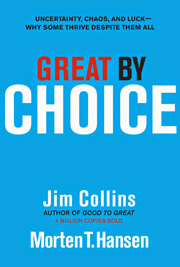JIM COLLINS’S BOOKS have occupied best-seller lists since 1997, and one of the dividends has been a collection of colorful metaphors that illuminate leadership concepts. “Level 5 leadership,” “right people on the bus,” “hedgehog concept,” and “flywheel,” the definitive metaphors of 2001’s Good to Great, have entered the lexicons of both for-profit and nonprofit leaders.
 |
| Great by Choice: Uncertainty, Chaos, and Luck -- Why Some Thrive Despite Them All by Jim Collins and Morten T. Hansen (HarperBusiness, 2011, 320 pp., $30) |
Now comes Collins’s latest work in his enduring study of how enterprises thrive. Great by Choice addresses the question from a new angle but serves up classic Collins— painstaking research, counterintuitive conclusions, and memorable metaphors. The subjects in Great by Choice are small or startup companies that became great in uncertain or chaotic environments and achieved returns at least 10 times greater than their industry’s returns over 15 or more years. Hence, they are the 10Xers, and they include Microsoft, Intel, Southwest Airlines and four others. Each is paired with a comparison case that failed to perform as well, or even failed to survive. (Ironically, since the cutoff was 2002, Microsoft’s comparison case is archcompetitor Apple, whose management practices in this period brought it close to extinction.)
As able a storyteller as he is an analyst, Collins frames his conclusions around the tale of explorers Roald Amundsen and Robert Falcon Scott, whose stories expose the salient themes of the book. Amunden, disciplined to the core, cautious, hyperprepared, and equipped for adversity, succeeded in his journey to the South Pole. Scott, risk-taking, impulsive, and lacking backup reserves, perished, along with his entire party. Like the subject companies, they were on the same journey but produced radically different outcomes.
Collins’s research reveals this surprising truth: Successful leaders are not more visionary, creative, bold, risk-taking, quick to act, or eager to change. Quite the contrary. They practice instead three essential behaviors: fanatic discipline, empirical creativity, and productive paranoia.
If there is one behavior that comes up time and again, it is fanatic discipline — discipline that enforces consistency of action in keeping with established performance standards, long-term goals, and sustaining values. Empirical creativity insists upon decision making grounded not in visionary genius, brilliant innovation, or unproven theory, but in rigorously derived evidence from practical experiments. Productive paranoia means every business must pay rigorous attention to changing conditions and preparation for unexpected events.
The authors then investigate the practices that support these behaviors and serve them up with engaging case studies, wrapped in those trademark metaphors that stick in the mind. Some are particularly pertinent and challenging for leaders of theological schools:
-
The 20-mile march, the unyielding insistence on achieving clear, appropriate, self-imposed performance markers, neither stretching too far in good times nor wavering in adversity.
-
Firing bullets, then cannonballs, the recipe for empirical decisions that demands careful experiments with limited risks before the launch of a major initiative. “We were relieved to discover that you don’t need any special predictive ability to thrive in uncertainty,” write the authors.
-
Extra oxygen canisters, the notion of preparing for adversity by building cash reserves, a practice seemingly out of reach for many but one that perhaps deserves greater attention.
-
Zooming out/zooming in, a dual-lens capability that demands continual assessment of the changing external environment, accompanied by rigorous processes to develop a disciplined response.
Can theological schools learn meaningful lessons from the likes of Microsoft and Southwest Airlines? Surely our environment is no less threatening and shifting. The practices illumined in Great by Choice offer leaders everywhere meaningful ways to respond to challenge and shape the future of their organization.